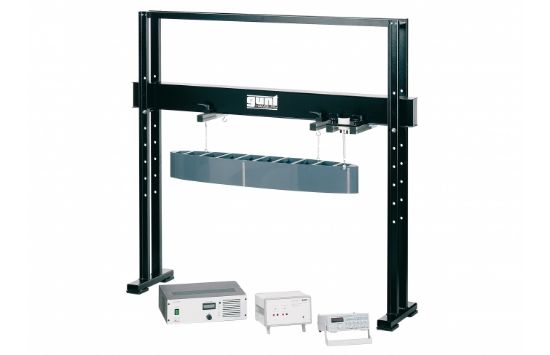Nowadays, experiment-based vibration analysis is an essential component in shipbuilding design and development.
The HM 159.11 unit helps students take their first steps in the field of experimental vibration analysis or modal analysis of structures. Using this trainer, the dynamic behaviour of a ship structure is studied, teaching students the fundamentals of experimental vibration analysis.
The HM 159.11 unit can be used to measure and record the natural frequencies and modes of a model ship. The simple, idealised ship shape makes it easier to approach the problem mathematically. The plastic model ship has nine ribs and an elliptical line plan.
The model ship is attached to a rigid cross-member by springs. The enclosed box cross-section with high rigidity means the natural frequency of the cross-member is negligibly high.
An electrodynamic vibration exciter causes the model ship to vibrate. A function generator produces the excitation signal, which can be adjusted in amplitude and frequency. An arbitrarily positionable acceleration sensor measures the model’s response to the excitation signal. In this manner, the transfer functions for various points of the model ship can be generated step by step. These can be used to determine the vibration modes for various natural frequencies. Experiments can also be conducted in water.
An additional tank is required to conduct these experiments (not included). Complementary experiments can be conducted with additional ballast and weights.

Natural vibration on a ship model
Nowadays, experiment-based vibration analysis is an essential component in shipbuilding design and development.
The HM 159.11 unit helps students take their first steps in the field of experimental vibration analysis or modal analysis of structures. Using this trainer, the dynamic behaviour of a ship structure is studied, teaching students the fundamentals of experimental vibration analysis.
The HM 159.11 unit can be used to measure and record the natural frequencies and modes of a model ship. The simple, idealised ship shape makes it easier to approach the problem mathematically. The plastic model ship has nine ribs and an elliptical line plan.
The model ship is attached to a rigid cross-member by springs. The enclosed box cross-section with high rigidity means the natural frequency of the cross-member is negligibly high.
An electrodynamic vibration exciter causes the model ship to vibrate. A function generator produces the excitation signal, which can be adjusted in amplitude and frequency. An arbitrarily positionable acceleration sensor measures the model’s response to the excitation signal. In this manner, the transfer functions for various points of the model ship can be generated step by step. These can be used to determine the vibration modes for various natural frequencies. Experiments can also be conducted in water.
An additional tank is required to conduct these experiments (not included). Complementary experiments can be conducted with additional ballast and weights.
